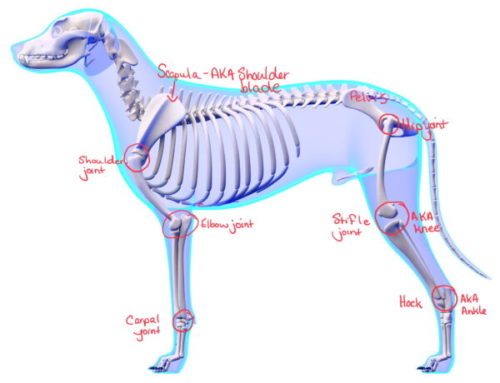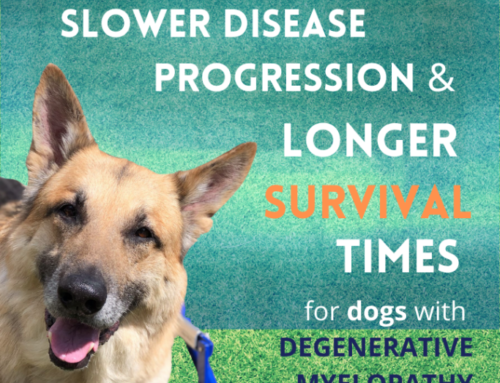 “I have a 10 year old German Shepherd. Every now and then she looked stiff and a little sore in her back end, then one day she woke up and couldn’t walk. I took her to the vet and they said it was likely DM (degenerative myelopathy). Now what do I do?”
“I have a 10 year old German Shepherd. Every now and then she looked stiff and a little sore in her back end, then one day she woke up and couldn’t walk. I took her to the vet and they said it was likely DM (degenerative myelopathy). Now what do I do?”
A woman came to me for help with her dog when going through one of the worst experiences a dog parent can go through. To have your dog wake and be unable to walk, and then be told your dog will get progressively worse.
Did this beautiful girl have the progressive spinal cord disease that would eventually lead to rear paralysis (inability to walk)?
The answer lies in ruling out other spinal cord and health conditions. Keep reading to learn more.
Not all conditions and injuries affecting your dog’s spine lead to permanent rear paralysis, nor do they all “feel” the same to your dog. When I went through this experience with my own dog, my first question was “does she have pain?”. And every dog parent that has a dog with rear paralysis wants to know if their dog will walk again.
Having as much information as possible in order to make a proper diagnosis helps you give your dog their best possible life. Check out this link to my website article for signs, symptoms, and how DM is diagnosed.

As a canine rehab therapist, we don’t treat all spinal cord injuries the same. We work with your vet and create tailored plans-of-care based on the diagnosis, clinical presentation, and your concerns/goals. (I say dog parent as most of my clients consider themselves to be “dog parents.”) Once I knew it was very likely Sammie had DM, I was able to work with others to keep her as active and independent for as long as possible, and I believe we actually slowed the disease progression through her tailored treatment plan.
What does DM look like?
By its very nature DM is a slow, non-painful progressive disease of the spinal cord.
Early signs of DM
- Clumsy (ataxic) walk/sway
- Lack of control of the hind end especially with changes in speed. Sometimes these dogs will “bunny hop” a little to go faster where they use both their hind legs simultaneously. Slowing down, their backend appears to “keep going” while their front end stops.
- Poor balance, sometimes standing with the feet close or crossed
- Knuckling/dragging of the hind paws – toenails start to get worn down. You may notice your dog weight bearing on the top of their paw.
- Rear weakness – sinking in the hind end in standing. Difficulty getting up from sitting or lying
- Absence of pain along the spine – no signs of neck or back pain
Key characteristics of DM that can differentiate it from other conditions
- Usually affects dogs 7-14 years old
- Slow onset
- Absence of pain along the spine
Diagnosing DM
DM is a diagnosis of elimination. We rule out as many other conditions as possible. Initially, your vet and/or rehab professional should get a full history of what happened (subjective history) then perform a clinical assessment (objective tests). These objective tests should include a neurologic assessment which examines your dog’s reflexes, sensation (ability to feel), coordination, and body awareness (proprioception).
X-rays and other spinal imaging techniques (myelography, CTs, MRIs) can be used to rule in/out other conditions such arthritis and disc bulges which may also be affecting our dogs’s mobility and comfort. Other tests such as cerebrospinal fluid (CSF) analysis, tissue biopsies, neuromuscular tests (testing electrical activity in the muscles) may be done.. Diseases like cancer can impact your dog’s mobility very quickly and it’s critical for your dog’s overall wellbeing to rule them out.

Research has shown that dogs with an “SOD-1 gene mutation” are at a higher risk of developing DM. There is a genetic test that dog parents can conduct at home and send away for analysis, that confirms whether or not your dog carries this gene mutation. Please note that this test by itself is not a “diagnosis” of DM. Your dog can carry the gene mutation and never show signs of the disease.
For more information or to order a test, I recommend the Orthopedic Foundation for Animals (OFA).
If the signs and symptoms, objective tests, and diagnostics lead your vet to believe your dog has DM, then you make plans to help your dog stay as independent and active for as long as possible. Studies have shown that while we can’t cure DM, we can slow the progression through exercise, nutrition, and integrative therapies.
To help you learn more about DM, exercises and things you can do at home to help your dog, we’ve created resources designed specifically for the dog parent. Learn more here
Making sense of it all
Do you need to do all these tests? Of course not. It is important to do some though, and not just assume that your dog has DM because of its breed. Pain should always be addressed, and eliminating other conditions helps us create the best plan of care for your dog. Not all dogs with rear paralysis will never walk with their hind legs again and I believe every dog parent has the right to know that.
If the signs and symptoms, objective tests, and diagnostics lead your vet to believe your dog has DM, then you make plans to help your dog stay as independent and active for as long as possible. Studies have shown that while we can’t cure DM, we can slow the progression through exercise, nutrition, and integrative therapies.
To help you learn more about DM, exercises and things you can do at home to help your dog, we’ve created a webinar and resources designed specifically for the dog parent. To check out this resource and our DM Group Program, please click here. We also have a private DM group called Navigating DM while Creating Connection. This group hosts our webinar plus lots of valuable presentations, exercise plans, and information to help you along your dog’s journey with DM.
Remember….
It’s not over, it’s just different.
And I know you’re still wondering…. yes, she walked again. Lots of canine rehab and a very dedicated dog mom got her using those back legs again.
References
Carol Beuchat, PhD. The lesson(s) from SOD1 and degenerative myelopathy. The Institute of Canine Biology. 5/1/2018.
Jean R. Coates, DVM, DACVIM. Degenerative myelopathy – diagnosis and treatment (Proceedings). DVM360, 2009.
I. Kathmann, et al. Daily controlled physiotherapy increases survival time in dogs with suspected degenerative myelopathy. J Vet Intern Med. 2006 Jul-Aug;20(4):927-32.
Lisa A. Miller, et al. “Retrospective Observational Study and Analysis of Two Different Photobiomodulation Therapy Protocols Combined with Rehabilitation Therapy as Therapeutic Interventions for Canine Degenerative Myelopathy.” Photobiomodulation, photomedicine, and laser surgery vol. 38,4 (2020): 195-205.
The Orthopedic Foundation for Animals. https://www.ofa.org/diseases/dna-tested-diseases/dm
Thomas Pfafman, DVM, CAC, et al., A multifaceted treatment protocol can slow, halt or even temporarily reverse the progression of degenerative myelopathy. Integrative management of degenerative myelopathy. February 10, 2017.
Zoe Polizopoulou, et al., Evaluation of a proposed therapeutic protocol in 12 dogs with tentative degenerative myelopathy. Acta veterinaria Hungarica. 56. 293-301.






